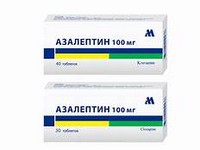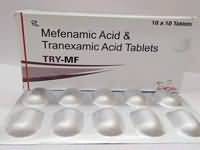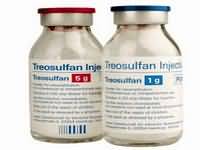Levomepromazine

Levomepromazine
CLINICAL USE
Treatment of schizophrenia Adjunctive treatment in palliative care Nausea and vomiting
DOSE IN NORMAL RENAL FUNCTION
Schizophrenia: Oral, initially 25–50 mg daily, increasing to 100–200 mg in 3 divided doses; maximum dose 1 g dailyPalliative care: Oral: 12.5–50 mg every 4–8 hours —IM/IV: 12.5–50 mg every 6–8 hours —SC Infusion: 5–200 mg daily —
PHARMACOKINETICS
Molecular weight :328.5 %Protein binding :No data %Excreted unchanged in urine : 1 Volume of distribution (L/kg) :23–42half-life – normal/ESRD (hrs) :30/– DOSE IN RENAL IMPAIRMENT
GFR (mL/MIN)
20 to 50 : Dose as in normal renal function 10 to 20 : Dose as in normal renal function <10 : Start with small dose and increase as necessary DOSE IN PATIENTS UNDERGOING RENAL REPLACEMENT THERAPIES
CAPD :Unknown dialysability. Dose as in GFR <10 mL/min HD :Unknown dialysability. Dose as in GFR <10 mL/min HDF/high flux :Unknown dialysability. Dose as in GFR <10 mL/min CAV/VVHD :Unknown dialysability. Dose as in normal renal function IMPORTANT DRUG INTERACTIONS
Potentially hazardous interactions with other drugs Anaesthetics: enhanced hypotensive effect Analgesics: increased risk of convulsions with tramadol; increased hypotension and sedation with opioid analgesicsAnti-arrhythmics: increased risk of ventricular arrhythmias due to prolongation of QT interval; increased risk of ventricular arrhythmias with amiodarone – avoid concomitant administrationAntibacterials: increased risk of ventricular arrhythmias with moxifloxacin – avoid concomitant administrationAntidepressants: possibly increased plasma level of tricyclics, increased antimuscarinic effects and ventricular arrhythmias; avoid concomitant administration with MAOIs (2 fatalities have been reported)Anticonvulsant: lowers anticonvulsant thresholdAntimalarials: avoid concomitant use with artemether/lumefantrineAntipsychotics: increased risk of ventricular arrhythmias with pimozide – avoid concomitant useAntivirals: plasma concentration possibly increased by ritonavirAntihypertensives: enhanced hypotensive effect; increased risk of ventricular arrhythmias with sotalolAnxiolytics and hypnotics: increased sedation Diuretics: enhanced hypotensive effect Lithium: increased risk of extrapyramidal effects and neurotoxicity Pentamidine: increased risk of ventricular arrhythmias – avoid concomitant useSibutramine: increased risk of CNS toxicity – avoid concomitant useLevomepromazine (methotrimeprazine).LEVoMEProMAZinE (METhoTriMEPrAZinE) 433 ADMINISTRATION
Reconstition
– Route
Oral, IV, IM, SC Rate of Administration
–Comments
For a subcutaneous infusion dilute in sodium chloride 0.9% and give via a syringe driverCompatible with diamorphine For IV injection, dilute with an equal volume of sodium chloride 0.9% OTHER INFORMATION
In renal disease there is an increased risk of cerebral sensitivity
See how to identify renal failure stages according to GFR calculation
See how to diagnose irreversible renal disease
Home









